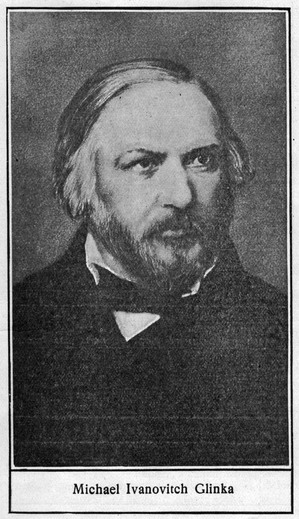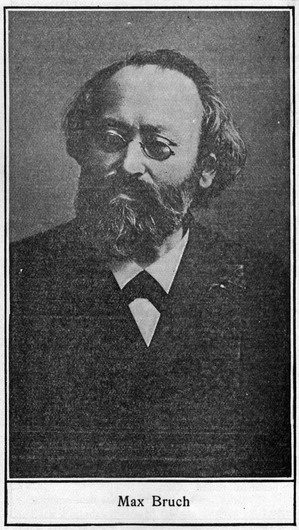Glinka was born at Novospasskoi, Smolensk, June 2, 1803, and died in Berlin, February 17, 1857. He was brought up on his father’s estate, and saturated with the peasant music of Russia. His musical training was desultory, interrupted by school in St. Petersburg (1817-22), by travel, and by government service. Nevertheless his teachers were the very best available, and included John Field. His first systematic instruction in composition was not received until 1833, when Dehn in Berlin superintended his work in this direction. His first opera, A Life for the Czar was produced in 1836, at St. Petersburg. It was an instantaneous success, and thoughtful musicians recognized in it the foundation of the modern “Russian School.” The next opera, Russlam and Lioudmilla, composed to a libretto by Poushkin, was a finer musical achievement, though it failed to win popularity on its production in 1842. Glinka gave up his work as choirmaster of the Imperial Chapel, and traveled in France and Spain. He became friends with Berlioz, with whom he had much in common. Upon his return he produced some orchestral pieces, including the Jota Aragonese, the Kamarinskaya and the Night in Madrid. He also wrote piano pieces, songs, chamber music, church music, etc. Liszt called him the “Prophet-Patriarch” of Russian music, and Tschaikowski greatly respected Glinka’s genius.
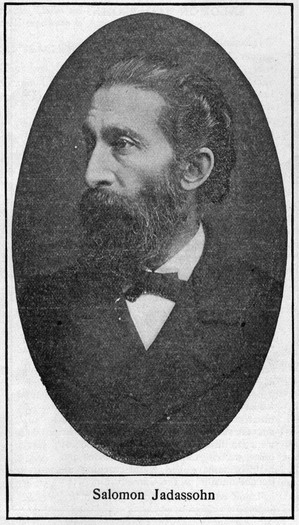 SALOMON JADASSOHN.
SALOMON JADASSOHN.
(Yah’-das-sohn)
Jadassohn was born at Breslau, September 3, 1831, and died at Leipsic, February 1, 1902. His studies were conducted partly at Breslau under Hesse, Lustner and Brosig, and partly at Leipsic (1848), partly with Liszt at Weimar and again at Leipsic in 1853 under Hauptmann. He remained in Leipsic for the remainder of his life, first as a teacher, then as conductor of the Euterpe concerts, and finally as teacher of Harmony, Counterpoint and Composition at the Conservatory. He was also instructor of the Pianoforte. The opus numbers of his compositions run well over a hundred, and his efforts in this direction include four symphonies, orchestral overtures, piano concertos, chamber music, besides smaller piano pieces such as the Children’s Dance, Scherzo and A Song of Love. Jadassohn, however, is best known as a theorist, as his works on Harmony, Counterpoint, Canon and Fugue, etc., have all been translated into English. His skill in counterpoint is shown in an orchestral serenade in canon, Op. 35. In 1887 he received the honorary degree of Doctor of Philosophy from the University of Leipsic, and in 1893 was appointed a Royal Professor. It is impossible to estimate the value of Jadassohn’s work as an educator. Practically everybody who went to Leipsic during his period of office passed under his instruction, and his works have had a far-reaching influence outside of the Conservatory.
Bruch was born at Cologne, January 6, 1838. His mother was his first teacher, and he studied theory with Breidenburg in Bonn. A four-year scholarship at Frankfort brought him under the instruction of Reinecke, Hiller and Breuning. He taught in Cologne 1858-61, and while there produced his first dramatic work. He was musical director at Coblentz, 1865-67. Other appointments he has held include that of capellmeister at Sondershausen, 1867-70; conductor of the Stern Choral Union, Berlin, 1878-80; conductor of the Philharmonic Society, Liverpool, England, 1880-83; and director of the Orchestral Society at Breslau 1883-92. He became head of the composition department at the Berlin Hochschule in 1892, from which he retired in 1910. Bruch visited Boston in 1883 where he brought out his oratorio Arminius. While Bruch has written in almost all forms, his work shows to best advantage when he is writing for chorus and orchestra. Such compositions as Fair Ellen, Odysseus and Arminius readily come to mind in this connection. The violin has also been a favorite instrument with Bruch, and his two concertos (especially the one in G minor) the Scottish Fantasia, and other works show how well he can write for this instrument. Bruch’s music is always rich in melody, well balanced in form, and abounds in beautiful sound effects.
 CHRISTIAN LOUIS HEINRICH KÖHLER.
CHRISTIAN LOUIS HEINRICH KÖHLER.
(Kay’-ler—almost Kurler).
Köhler was born September 5, 1820, at Brunswick, and died at Konigsberg, February 16, 1886. He was first educated in Brunswick where his teachers were A. Sonnemann (piano), Chr. Zinkeisen, Sr., J. A. Leibrock (theory) and Chr. Zinkeisen, Jr. (violinist). In Vienna (1839-43), he was further instructed by Sechter and von Seyfried (theory and composition) and, on the advice of Czerny, by Bocklet (piano). For a short time Köhler was theater capellmeister at Marienburg and Elbing, but in 1847 he settled down in Konigsberg, first as theater capellmeister and later as director of a school of music, conductor of the vocal society, critic and composer. To the majority of people Köhler stands for piano studies. His contributions to the technical side of piano playing have been many and valuable, and such works as his First Studies, Op. 50, his New School of Velocity, Op. 128, and his Very First Exercises, Op. 128, have probably found a place in every pianist’s music library. It is doubtless for such work as this that he has been styled the “heir of Czerny.” Nevertheless he was a noteworthy composer in other fields, and his works include three operas, one of which Maria Dolores was produced at Brunswick in 1844. In addition must be mentioned his valuable contributions to the current musical literature of his day.
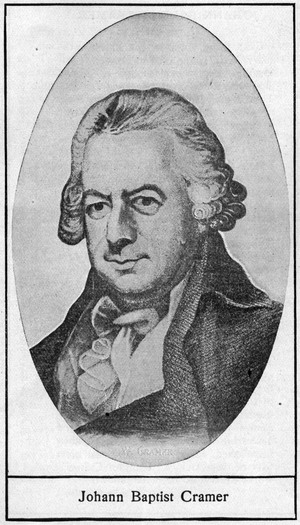 JOHANN BAPTIST CRAMER.
JOHANN BAPTIST CRAMER.
(Krah’-mer)
Cramer was born at Mannheim, February 24, 1771, and died in London, April 16, 1856, living long enough to play a duet with Liszt at a concert in London. The Cramer family, like the Bachs, were noted musicians, and Johann was brought to London when but a year old, when his father was appointed head of the King’s Band. Cramer was a pupil of Benser, Schröter and, above all, of Clementi. He was practically self taught in composition. He commenced very successful concert tours in 1788 on the continent, but made London his home, except from 1832 to 1845, when he lived in Paris. He went into partnership with Addison in 1824 and founded the publishing firm which still bears his name. Cramer enjoyed a great reputation, and Ries declared that Beethoven regarded him as the foremost player of his time. His compositions, consisting of 105 sonatas, a quartet and a quintet for piano, rondos, variations, etc., are almost wholly forgotten. The Cramer Studies, however, are second only in importance to the Clementi Gradus. The most noted of these are the eightly-four (sic) which form the fifth part of his Grosse Praktische Pianoforte-Schule. Von Bülow conferred a blessing upon all piano students when he selected, edited and commented upon fifty of these studies. Many of Cramer’s works deserve to be better known.
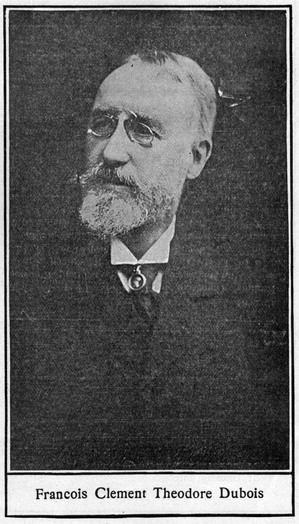 FRANCOIS CLEMENT THEODORE DUBOIS.
FRANCOIS CLEMENT THEODORE DUBOIS.
(Dü-bwah’)
Dubois was born at Rosney (Marne), August 24, 1837. He came to Paris when young and studied at the Conservatorie. He gained many prizes, and finally carried off the Prix de Rome in 1861, his teachers having been Marmontel (pf.), Benoist (org.), Bazin (harm.) and Ambroise Thomas (fugue and comp.). After returning from Italy in 1866 he was appointed maitre de chapelle at Ste.-Clothide. He also occupied a similar post at the Madeleine, succeeding Saint-Saëns as organist there in 1877. He became successively professor of Harmony (1871), of Composition (1891), and finally Director at the Paris Conservatoire, and was elected to the Acadèmie in succession to Gounod in 1894. Dubois’s compositions include operas, orchestral music, church music, piano pieces, etc. His best known work in America is probably his Seven Last Words, while his organ pieces, including such works as the brilliant Toccata in G, the March of the Magi Kings, the Fiat Lux, and In Paradisum are great favorites with organists. The piano works of Dubois are also popular, especially the Fanfare, and the Scherzo et Choral. His influence as an educator has been very great, as many noted French composers have received their training through him.


